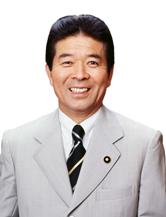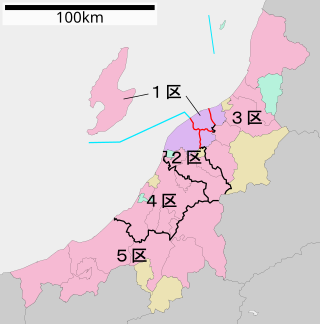Aichi Prefecture currently sends 34 elected members to the Diet of Japan, 26 to the House of Representatives and 8 to the House of Councillors.
Aichi Prefecture currently sends 34 elected members to the Diet of Japan, 26 to the House of Representatives and 8 to the House of Councillors.
The current House of Representatives Aichi delegation consists of 14 members of the LDP, 6 CDP, 2 Ishin, 1 DPFP, 1 Komeito, 1 JCP, and 1 independent.
Aichi Prefecture is part of the Tokai proportional representation block. In the current Diet, there are 14 Representatives from Aichi elected through the Tokai PR block.
| Representative | Party | District contested | Incumbency |
|---|---|---|---|
 Shuhei Aoyama | Liberal Democratic | Aichi-12th | 5 February 2019 – present |
 Taku Ishii | Aichi-13th | 31 October 2021 – present | |
 Takamoto Nakagawa | Aichi-2nd | 31 October 2021 – present | |
 Yutaka Banno | Constitutional Democratic | Aichi-8th | 31 October 2021 – present |
 Tsunehiko Yoshida | Aichi-1st | 22 October 2017 – present | |
 Yoshio Maki | Aichi-4th | 22 October 2017 – present | |
| Kazumi Sugimoto | Ishin | Aichi-10th | 22 October 2017 – present |
| Maki Misaki | Aichi-5th | 31 October 2021 – present | |
 Wataru Itō | Komeito | None | 16 December 2012 – present |
| Nobuko Motomura | Communist | None | 14 December 2014 – present |
 Yoshitaka Ikeda | Independent | Aichi-3rd | 14 December 2014 – present |
The current House of Councillors Tokyo delegation consists of 2 members of the LDP, 2 CDP, 2 Komeito, 1 DPFP, and 1 independent. The members are elected from the Aichi at-large district. The Aichi Councillors delegation will grow to eight after the 2019 election.
| Class | # | Councillors | Party | Term ends | Incumbency |
|---|---|---|---|---|---|
| 2019 | 1 |  Yasuyuki Sakai | Liberal Democratic | 28 July 2025 | 29 July 2013 – present |
| 2 |  Kohei Otsuka | Independent | 28 July 2025 | 29 July 2001 – present | |
| 3 |  Maiko Tajima | Constitutional Democratic | 28 July 2025 | 29 July 2019 – present | |
| 4 |  Nobuo Yasue | Komeito | 28 July 2025 | 29 July 2019 – present | |
| 2022 | 1 |  Masahito Fujikawa | Liberal Democratic | 25 July 2028 | 26 July 2010 – present |
| 2 |  Ryūji Satomi | Komeito | 25 July 2028 | 26 July 2016 – present | |
| 3 | Yoshitaka Saitō | Constitutional Democratic | 25 July 2028 | 26 July 2010 – present | |
| 4 |  Takae Itō | DPFP | 25 July 2028 | 26 July 2016 – present |

The National Diet is the national legislature of Japan. It is composed of a lower house, called the House of Representatives, and an upper house, the House of Councillors. Both houses are directly elected under a parallel voting system. In addition to passing laws, the Diet is formally responsible for nominating the Prime Minister. The Diet was first established as the Imperial Diet in 1890 under the Meiji Constitution, and took its current form in 1947 upon the adoption of the post-war constitution. Both houses meet in the National Diet Building in Nagatachō, Chiyoda, Tokyo.

Nara Prefecture is a prefecture of Japan located in the Kansai region of Honshu. As of 2020, Nara Prefecture has a population of 1,321,805 and has a geographic area of 3,691 square kilometres (1,425 sq mi). Nara Prefecture borders Kyoto Prefecture to the north, Osaka Prefecture to the northwest, Wakayama Prefecture to the southwest, and Mie Prefecture to the east.

The House of Representatives is the lower house of the National Diet of Japan. The House of Councillors is the upper house. The composition of the House is established by Article 41 and Article 42 of the Constitution of Japan. The House of Representatives has 465 members, elected for a four-year term. Of these, 176 members are elected from 11 multi-member constituencies by a party-list system of proportional representation, and 289 are elected from single-member constituencies.

The House of Councillors is the upper house of the National Diet of Japan. The House of Representatives is the lower house. The House of Councillors is the successor to the pre-war House of Peers. If the two houses disagree on matters of the budget, treaties, or the nomination of the prime minister, the House of Representatives can insist on its decision. In other decisions, the House of Representatives can override a vote of the House of Councillors only by a two-thirds majority of members present.

The Japanese political process has two types of elections.

Masashi Nakano is a Japanese politician and former Secretary-General of the Party for Japanese Kokoro.

Akihiro Ota is a Japanese politician of the Komeito Party, currently serving his seventh term in the House of Representatives in the National Diet. Ota has represented three districts within the Tokyo metropolis since first entering the national Diet in 1993. He served as president of the Komeito Party from 2006 until the general election in September 2009, at which time he lost his seat in the Diet. Upon his return to the House in December 2012, Ota was appointed as the Minister of Land, Infrastructure, Transport and Tourism, a post he held until October 2015.

The Tōkyō proportional representation block, or more formally the proportional representation tier "Tokyo Metropolis electoral district", is one of eleven proportional representation (PR) "blocks", multi-member constituencies for the House of Representatives in the Diet of Japan. It consists solely of the prefecture of Tokyo making it one of two blocks covering only one prefecture, the other being Hokkaido. Following the introduction of proportional voting Tokyo elected 19 representatives by PR in the 1996 general election, and 17 since the election of 2000 when the total number of PR seats was reduced from 200 to 180.
Politics of Kanagawa, as in all prefectures of Japan, takes place in the framework of local autonomy that is guaranteed by the Constitution and laid out in the Local Autonomy Law. The administration is headed by a governor directly elected by the people every four years in first-past-the-post elections. Legislation, the budget and the approval of personnel appointments, including the vice governors, are handled by the prefectural assembly that is directly elected by the people every four years by single-non transferable vote.
Politics of Osaka, as in all 47 prefectures of Japan, takes place in the framework of local autonomy that is guaranteed by chapter 8 of the Constitution and laid out in the Local Autonomy Law. The administration is headed by a governor directly elected by the people every four years in first-past-the-post elections. Legislation, the budget and the approval of personnel appointments, including the vice governors, are handled by the prefectural assembly that is directly elected by the people every four years by single-non transferable vote.

House of Councillors elections were held in Japan on Sunday 10 July 2016 to elect 121 of the 242 members of the House of Councillors, the upper house of the National Diet, for a term of six years. As a result of the election, the Liberal Democratic Party–Komeito coalition gained ten seats for a total of 145, the largest coalition achieved since the size of the house was set at 242 seats.
The Tottori-Shimane at-large district is a constituency of the House of Councillors in the Diet of Japan. It was formed pursuant to a 2015 revision of the Public Officers Election Law from a merger of the Tottori and Shimane at-large districts, the two smallest districts in the country, to address the imbalance in representation between rural and urban voters. The district has 1,068,348 registered voters and was contested for the first time at the House of Councillors election that was held on 10 July 2016.

Hokkaido currently sends 26 elected members to the Diet of Japan, 20 to the House of Representatives and 6 to the House of Councillors. The prefecture sends 6 Councillors after the 2019.

Okinawa currently sends 8 elected members to the Diet of Japan, 6 to the House of Representatives and 2 to the House of Councillors.

Tokyo currently sends 53 elected members to the Diet of Japan, 42 to the House of Representatives and 11 to the House of Councillors.

Niigata currently sends 12 elected members to the Diet of Japan, 10 to the House of Representatives and 2 to the House of Councillors. The prefecture lost 1 Councillor due to reapportionment in 2019.

House of Councillors elections were held in Japan on 21 July 2019 to elect 124 of the 245 members of the House of Councillors, the upper house of the then 710-member bicameral National Diet, for a term of six years.
The Group of Independents was a parliamentary group in the House of Representatives, the lower house of the Japanese National Diet. It consisted exclusively of non-party deputies, many of whom were formerly members of the Democratic Party.